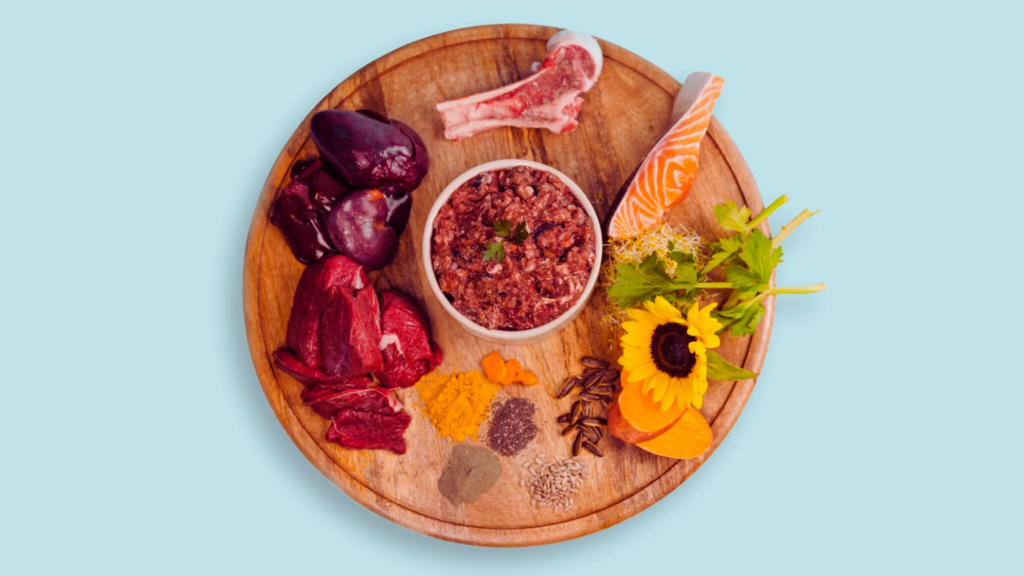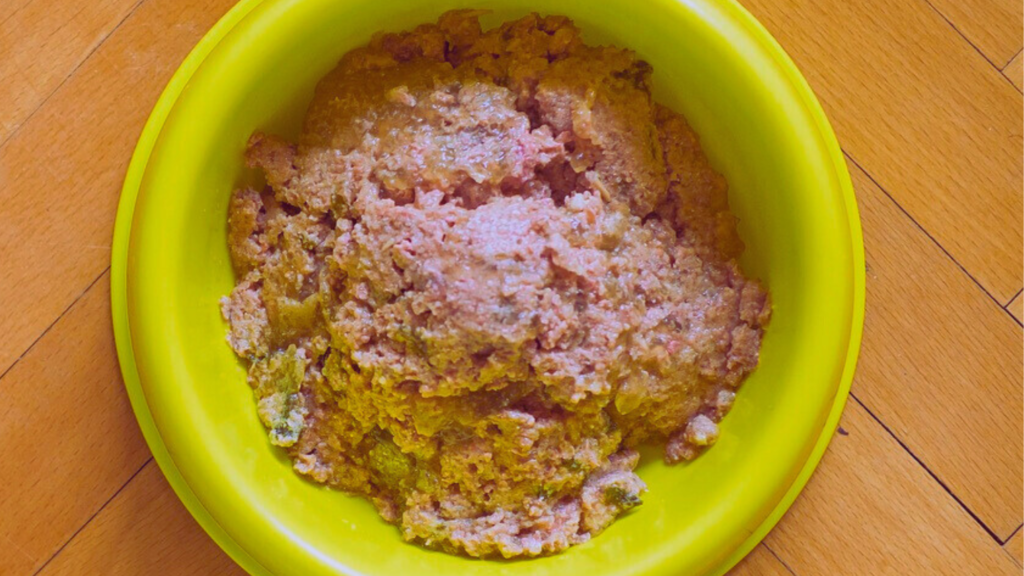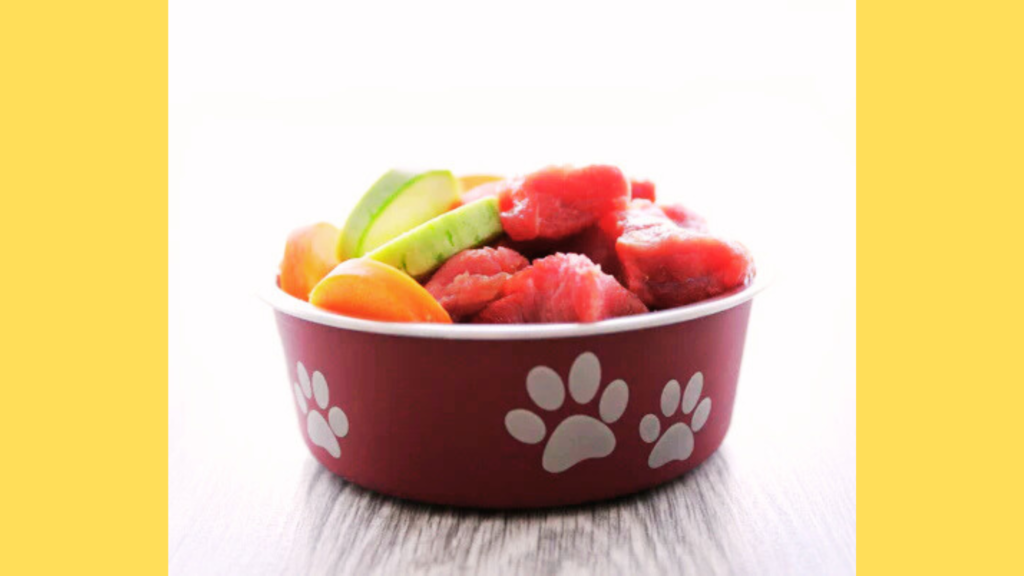| Summary: A raw diet has both benefits and risks. Supporters claim it leads to shinier coats, better digestion, and increased energy, while critics warn of bacterial contamination, nutritional imbalances, and choking hazards. The best diet depends on the dog’s needs, lifestyle, and the owner’s ability to provide a well-balanced meal plan. |
The debate over what constitutes the best diet for dogs has been ongoing for years. While commercial kibble has been the standard for decades, many pet owners are now exploring raw feeding as an alternative. So, is a raw diet better for dogs? A raw diet aims to mimic what dogs’ ancestors consumed in the wild, consisting mainly of raw meat, bones, and organ meats, with occasional fruits and vegetables.
Proponents argue that raw diets offer numerous health benefits, including shinier coats, improved digestion, and increased energy. However, critics warn of potential risks such as bacterial contamination, nutritional imbalances, and choking hazards. For a comprehensive guide including comfort and safety tips, check out this article on Which Harness Is Ideal for a Pomeranian?.
To determine if a raw diet is truly better for dogs, we must examine its benefits, drawbacks, and scientific research. By analyzing the nutritional requirements of dogs and weighing the pros and cons, pet owners can make an informed decision about their dog’s dietary needs.
Quick Comparison Table
This Quick Comparison Table breaks down key factors to help answer “Is a Raw Diet Better for Dogs?” Compare nutrition, benefits, cost, and convenience at a glance.
Blog Highlights
ToggleWhat is a Raw Dog Food Diet

A raw diet, often referred to as the BARF (Biologically Appropriate Raw Food) diet, consists of uncooked and unprocessed food items. The aim is to provide a natural diet similar to what wild dogs and wolves consume. Discover if the American Eskimo is a guard dog and learn about its suitability for protecting your home.
Common components of a raw diet include
- Raw muscle meat from sources such as beef, chicken, turkey, or fish
- Raw edible bones that provide calcium and promote dental health
- Organ meats including liver, kidneys, and heart for essential nutrients
- Fresh vegetables and fruits such as carrots, spinach, apples, and blueberries
- Dairy and supplements like eggs and omega-3 oils
This approach eliminates preservatives, artificial ingredients, and excessive carbohydrates commonly found in commercial dog food, offering a whole-food-based diet.
Is a Raw Diet Better For Dogs: The Benefits of a Raw Diet
1. Improved Digestion and Nutrient Absorption
One of the most significant advantages of a raw diet is enhanced digestion. Kibble often contains grains, fillers, and artificial additives that can be difficult for some dogs to digest. In contrast, raw food is more natural for their digestive systems, leading to better nutrient absorption and a healthier gut.
Dogs on a raw diet typically experience firmer stools, reduced bloating, and fewer gastrointestinal issues. Since the food is less processed, it retains more of its natural enzymes, which can aid digestion.
2. Healthier Skin and Shinier Coat

A raw diet is rich in essential fatty acids, particularly omega-3s, which contribute to healthy skin and a glossy coat. Many pet owners notice a significant improvement in their dog’s fur quality after transitioning to raw feeding. The absence of artificial preservatives and allergens in processed foods also helps reduce skin irritations and allergic reactions.
Dogs suffering from chronic skin conditions or excessive shedding may benefit from the natural oils found in raw meats and fish, leading to an overall healthier appearance.
3. Increased Energy and Muscle Development
Protein is the primary fuel source in a raw diet, providing sustained energy for active dogs. Dogs that engage in high-energy activities, such as agility training, hunting, or herding, may thrive on a raw diet due to its high protein and fat content.
The diet also supports lean muscle mass development, helping dogs maintain a strong physique. The natural calcium and phosphorus found in raw bones contribute to robust skeletal structure, benefiting dogs of all breeds and ages.
4. Better Dental Health

Dental disease is a common problem in dogs, often caused by the buildup of plaque and tartar from carbohydrate-rich diets. While some kibbles claim to promote dental health, they can still leave residue on teeth.
Chewing on raw bones naturally helps remove tartar and strengthen jaw muscles. Many raw-fed dogs have whiter teeth and fresher breath without needing frequent dental cleanings. This benefit can lead to fewer visits to the vet and a lower risk of gum infections. Learn about the size collar for an American Eskimo to ensure a perfect fit and comfort for your dog.
5. Reduced Allergies and Food Sensitivities
Commercial dog foods often contain common allergens such as wheat, corn, soy, and artificial additives. These ingredients can trigger food allergies, leading to symptoms like itching, ear infections, and digestive issues.
A raw diet eliminates most of these allergens, allowing dogs to thrive on whole, unprocessed foods. This makes raw feeding an excellent option for pets with sensitive stomachs or chronic allergy symptoms.
The Risks and Concerns of a Raw Diet
Bacterial Contamination

One of the primary concerns regarding raw feeding is the risk of bacterial contamination. Raw meat can carry harmful bacteria such as Salmonella, E. coli, and Listeria, which can pose risks to both dogs and their owners.
While dogs have strong stomach acids that can handle some bacteria, immunocompromised pets may still be susceptible to infections. Additionally, bacteria from raw meat can spread through dog saliva and feces, potentially contaminating household surfaces and putting humans at risk.
Proper handling, freezing, and hygiene measures can minimize these risks. Washing hands, cleaning food bowls, and disinfecting surfaces can help maintain a safe feeding environment.
Nutritional Imbalances
A well-balanced diet is crucial for a dog’s health, and ensuring that a raw diet meets all nutritional requirements can be challenging. Feeding only raw meat without organ meats or bones can lead to deficiencies in essential vitamins and minerals.
For example, an incorrect calcium-to-phosphorus ratio can result in bone disorders, particularly in growing puppies. Too much liver can lead to vitamin A toxicity, while a lack of fiber from vegetables may cause digestive issues. Pet owners must follow properly formulated recipes or consult a veterinary nutritionist to avoid imbalances.
Choking Hazards and Internal Injuries
Feeding whole bones, while beneficial for dental health, comes with risks. Dogs may choke on small bones, fracture their teeth on hard bones, or suffer from internal injuries if bones splinter.
Cooked bones are especially dangerous as they become brittle and can puncture the intestines. Pet owners must choose appropriate bones and monitor their dogs while eating to prevent accidents. Discover why Afghan Hound collars are wide by exploring the unique characteristics of this breed and how wide collars enhance their comfort and style.
Cost and Convenience
A raw diet can be more expensive than commercial kibble. The cost of high-quality raw meats, supplements, and storage solutions can add up, making raw feeding a less affordable option for some pet owners.
Additionally, raw feeding requires careful meal planning and preparation. Unlike kibble, which is convenient and easy to store, raw diets demand refrigeration or freezing to maintain freshness. This extra effort may not be practical for every dog owner.
Scientific Research on Raw Diets
Research on raw feeding is still evolving, with studies highlighting both benefits and risks. Some studies indicate that raw-fed dogs have a healthier gut microbiome and improved nutrient absorption. A 2019 study in Frontiers in Veterinary Science found that dogs on raw diets had more beneficial gut bacteria than those on kibble.
However, other research suggests that domesticated dogs have adapted to digest starches, making them capable of thriving on both raw and cooked diets. A 2013 study published in Nature revealed that dogs have evolved to digest carbohydrates more efficiently than wolves, indicating that they do not necessarily require a raw diet to stay healthy.
Veterinarians remain divided on raw feeding, with some advocating for it and others warning against potential health risks. More long-term studies are needed to determine the full impact of raw diets on canine health.
The Impact of a Raw Diet on a Dog’s Long-Term Health
One of the most debated aspects of raw feeding is its long-term impact on a dog’s health. While proponents of raw diets claim that dogs thrive when fed natural, unprocessed foods, critics argue that the risks outweigh the benefits. To fully understand the long-term effects, we must examine various health factors, including lifespan, disease prevention, immune function, and overall well-being.
Longevity and Quality of Life
Many raw feeders report that their dogs live longer, healthier lives compared to kibble-fed counterparts. The argument is based on the principle that a diet free from artificial additives, preservatives, and excessive carbohydrates helps maintain optimal organ function and reduces the risk of chronic diseases.
While scientific research on raw diets and longevity is still limited, some studies suggest that dogs on fresh, balanced diets may have improved health markers associated with increased lifespan
One potential reason for increased longevity is the absence of ultra-processed ingredients, which have been linked to inflammation and metabolic disorders. Inflammation is a major contributor to diseases such as arthritis, cancer, and diabetes.
A raw diet, rich in natural antioxidants, omega-3 fatty acids, and high-quality protein, can help reduce systemic inflammation and promote cellular health.
Disease Prevention and Immune System Support
A raw diet is often credited with strengthening a dog’s immune system. The fresh, bioavailable nutrients in raw food can enhance immune response, making dogs less susceptible to infections, allergies, and autoimmune conditions. For example, a diet rich in vitamins C and E, found in fresh fruits and vegetables, supports immune function by reducing oxidative stress and boosting white blood cell activity.
Moreover, gut health plays a critical role in immune defense. A well-balanced raw diet can contribute to a diverse and healthy gut microbiome, which is essential for proper digestion and immune system regulation. The presence of natural probiotics in raw food, such as those found in raw green tripe and fermented vegetables, can further support beneficial bacteria in the digestive tract.
However, an improperly balanced raw diet can have the opposite effect. Deficiencies in key nutrients, such as zinc, vitamin D, and taurine, can lead to weakened immunity, skin infections, and organ dysfunction. This highlights the importance of carefully formulating a raw diet to meet all of a dog’s nutritional needs.
Impact on Chronic Conditions
Dogs suffering from chronic conditions such as obesity, diabetes, and kidney disease may see improvements when switched to a raw diet. The natural, low-carbohydrate composition of raw food helps regulate blood sugar levels, making it a suitable option for diabetic dogs. Additionally, raw feeding eliminates unnecessary fillers and artificial flavor enhancers, which can contribute to weight gain and metabolic imbalances.

For dogs with kidney disease, a raw diet must be carefully managed. High protein levels can place extra strain on compromised kidneys, but adjusting protein sources and incorporating moisture-rich foods can support kidney function. Consulting with a veterinary nutritionist is crucial when managing chronic conditions through diet.
While anecdotal evidence strongly supports the long-term benefits of raw feeding, more controlled scientific studies are needed to confirm these claims. Regardless of the feeding approach, the key to a dog’s long-term health is a well-balanced diet, whether raw or cooked, that meets all of their nutritional needs.
Wrapping Up
A raw diet offers numerous benefits, including improved digestion, healthier skin, increased energy, better dental health, and reduced allergies. However, it also comes with risks such as bacterial contamination, nutritional imbalances, and potential choking hazards.
The decision to switch to raw feeding should be based on a dog’s individual needs, lifestyle, and the owner’s ability to provide a balanced diet. Some dogs thrive on raw food, while others do well on high-quality kibble or cooked diets. Hope so, now you know the answer: Is a raw diet better for dogs?
Ultimately, the best diet is one that meets a dog’s nutritional needs and promotes long-term health. Whether raw or cooked, ensuring a balanced, nutrient-rich diet is key to a happy and healthy pet. The recommended size collar for an English Cocker Spaniel usually ranges from 12 to 18 inches, providing a snug and comfortable fit for your dog.





